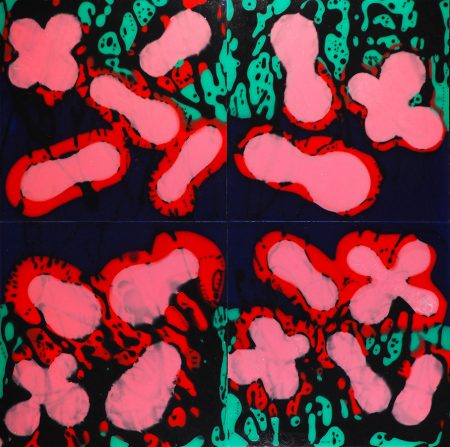Bookending the extensive career of Henri Matisse was his phenomenal series known as the cut-outs. Making their way to the art scene in the 1940s and 50s, these works surprised and surpassed many of his past contributions. As Matisse journeyed into this new and final territory, he unearthed successful discoveries still yet to be realized in his personal repertoire. While you won’t find these French finesses at 124 West Pike Street Gallery, you will find a modern-day emergence of a similar sentiment in Susan Byrnes’ Viscosity Series.
A sculptor by trade, Byrnes’ technical expertise is within the 3-D realm. Taking her informed practice of sculpture, Byrnes offers up her understanding of dimension and depth to the 2-D world, and quite successfully so. By way of molds and molten, the artist explores and expands the confines of art object and fine art picture.
Painting with scissors
During the cut-out era, Matisse’s artistry flourished in his elemental but dynamic compositions, favoring form, color, and line. He is famously quoted for his delightful take on this epoch, describing his technique as “painting with scissors”. If such is true of Matisse’s process, then we can affectionately say that Byrnes is ‘drawing with sculpture’.
Modest in size, Untitled (Study 6) gives way to a Matisse-like study in formalism. It is bold, bright, and unapologetic, juxtaposing color with form and form with space.
Honing in on such rudimentary elements, Untitled (Study 6) is a marriage of artist intent and material will. The medium, both unforgiving and docile, allows form to take shape in a monitored but variable environment. The outcome both relies and denies artist sanction, yielding compositions of poignant proportions. This quasi-autonomy that exists within the work renders forms that are playful yet definitive, abstract yet relatable. See Untitled (Study 11) and Untitled (Study 12) below for other stand-outs from this study series.
There are always flowers
Inherent in the Viscosity Series is the practice of reproduction – the studies, the iterations all point to this natural process. We see it in a technical sense and equally so from a conceptual standpoint. Matisse, too, reveled in lush landscapes, simplifying and impression-izing floral and fauna into bright patterns and compositions. A garden of gestures and guesswork, Byrnes’ nature motif blossoms beautifully in Begonias.
Flowery and fertile, Begonias is successful in all senses of the word. Its pinky, embryonic quality points to reproduction from a biological sense, while its repetitious, mirror-like composition renders the loveliness of the material and technical process. We watch the work take its natural course while subscribing to the artist’s dictation. It’s nature at its finest: wholly unyielding while pliant when called.
I have waited at the gates
Time, with all work, is of the essence, but especially for Byrnes (and God save, Matisse). Meddling with time and material, Byrnes’ process is both her friend and her foe. The temperance and permanence of the viscous liquid requires her to both interrupt and submit to the curing process. What yields from these transactions is a meeting place of opposite ends, where balance is found between the two, and notably so in Clouds (1, 2, 3, and 4).
Through her drawn sculpture, Byrnes freezes the fluidity of the material, implying the passing of time and the harnessing there of. She achieves depth not only through the physicality of the layered casts, but through transparency and opacity, as well. Clouds (1, 2, 3, and 4) encompass the transient yet impenetrable quality of the material, held together wonderfully between frame and fixture. On a larger more conceptual scale, we know this to be true of all work: the changing of material through the passing of time. This was found in Matisse’s work as the color faded (and fades) from the gouache paper cut-outs. Brynes captures the spirit of this notion by exposing the ephemeral nature of her process bringing it beautifully to the forefront of her work.
Was Byrnes pursing a Matisse motif, a French 1950’s aesthetic, or concept mirroring the late master? Not explicitly so. But perhaps rooted in this particular body of work is an implicit traversing of similar grounds, where one artist has taken foothold where the other left off. To parallel Brynes with Matisse is not to equate one to the other; it is to view the work in light of the art world at large, which always makes the former (and the latter) shine a little brighter.
Susan Brynes’ Viscosity Series is on display now through June 30, 2018, at 124 West Pike Street Gallery in Covington, Kentucky.












July 8th, 2018at 12:40 pm(#)
Loved the article, written about a wonderful professional artist, who opens doors to ideas and exciting new visions. Thank you.
Suzanna Terrill